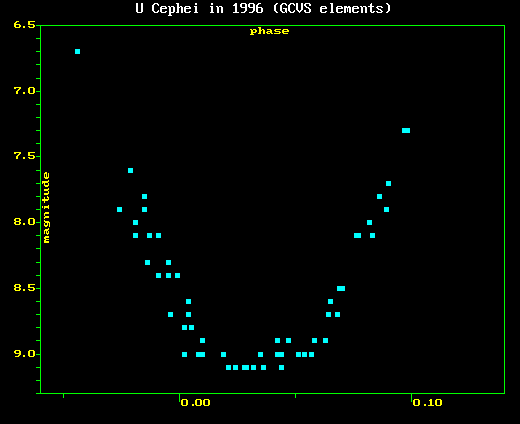
Much can be learnt from amateur observations of eclipsing variables. Although the times of eclipses can usually be predicted fairly accurately (to within an hour or so), not even the brightest variables such as Algol and Beta Lyrae are in step with the GCVS elements.
Discrepancies can occur for various reasons: there may be mass transfer between the two stars; the gravitational effect of a third star in the system may affect the period; there may be errors in the elements, either in the epoch or the period.
Even if a variable has been eclipsing in line with the predictions for many years, there is no guarantee that it will continue to do so. RZ Cas for example, was eclipsing more or less in line with the predictions until the late 1980s, but during the 1990s it has started to diverge significantly from the predictions.
The accompanying light curve shows the primary eclipse of U Cephei in 1996. If eclipses were occurring on schedule, the light-curve would be centred on phase 0. Clearly it is shifted to the right, and is centred at about phase 0.03, which is over 90 minutes late.

If you compare the number of observations made of eclipsing variables by section members with the numbers of observations of semi-regular variables or eruptive variables, it is clear that eclipsing variables fare rather poorly.
This is a shame for several reasons. As already mentioned, the times of eclipses can be predicted fairly accurately in advance; the same is not true of the outbursts of most eruptive variables. Additionally, by making estimates every 20-30 minutes, you can see most, or the whole of an eclipse within one night. Often the whole eclipse can be observed before midnight. You have to be a lot more patient to see the brightness variations of semi-regular variables !
It is not essential to observe the whole of an eclipse in one night. It is possible to merge observations made of several different eclipses on different nights into a single light curve.
Of course one difficulty is knowing when a particular variable is going to be in eclipse. Discovering eclipses by trial and error can be very time consuming. Various catalogues do give the epoch (i.e. time of a previous eclipse) and the period. These can be used to calculate the predicted times of future eclipses. However, this can be very tedious if all you have is a calculator and at the end of it, you have to convert Julian dates to calendar dates.
Fortunately the advent of PCs has made life easier. Once you have worked out how to perform calculations in spreadsheets, all you have to do is enter the relevant formula (based on the epoch and period of the variable), highlight the cells involved, and then fill down to obtain predictions for as many future dates as you wish. If you require help with this, please ask me.
There are approx 130 eclipsing variables on the section's programme - a full list was included in VSSC 93, and is also included here. (also see Epochs and Periods for EBs)
So if you do not currently observe eclipsing variables, do give them a try. Eclipsing binary predictions are also now included here from the Home page.